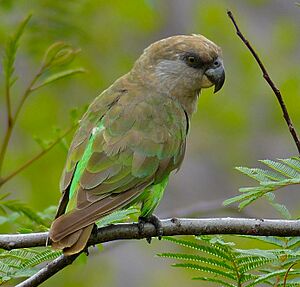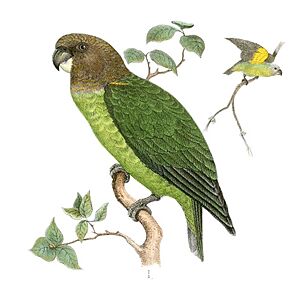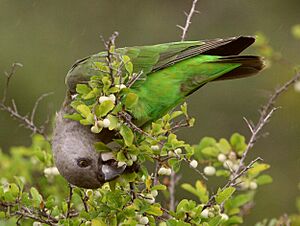Brown-headed parrot facts for kids
Quick facts for kids Brown-headed parrot |
|
|---|---|
 |
|
| In Kruger National Park, South Africa | |
| Conservation status | |
| Scientific classification | |
| Genus: |
Poicephalus
|
| Species: |
cryptoxanthus
|
The brown-headed parrot (Poicephalus cryptoxanthus) is a cool green parrot. It lives in southeastern Africa. These birds are known for their sweet nature. They are also quieter than many other parrots. This makes them popular pets for people who love birds.
Contents
What Does the Brown-Headed Parrot Look Like?
This parrot is mostly green. Some experts even call it "the greenest parrot" in its area. Its feathers under the wings are bright yellow. This yellow color is actually where the parrot gets its scientific name. Kryptos is a Greek word meaning "hidden." Xanthos is Greek for "yellow." So, its name means "hidden yellow."
The parrot's lower back is a very bright, shiny green. The edges of the feathers on its belly are also green. This green color gets brighter near its legs. Its neck is grey-brown. This color blends into brown on its head. It turns greenish on its back. Sometimes, you might see random yellow feathers on its head, neck, or wings. No one knows exactly why these appear. Some think it might happen if parent birds preen their chicks too much.
The tail feathers have olive-brown edges. Their tips are green. The parrot's eyes are greenish-yellow or yellow. Its legs and feet are dark grey. The top part of its beak is dark, almost black. The bottom part is whitish. Young parrots look a bit duller than adult birds. They also have a yellowish color on their undersides. These parrots fly very fast and straight.
Where Do Brown-Headed Parrots Live?
Scientists have identified different types of brown-headed parrots. These types are called subspecies. They are based on small differences in color and size.
- The P. cryptoxanthus cryptoxanthus lives in northern KwaZulu-Natal. This area is in South Africa. It also lives north into southern Mozambique and southeastern Zimbabwe.
- The P. cryptoxanthus tanganyikae looks paler and more greenish. It has less brown on its head, throat, neck, and back. Its belly feathers look brighter and more yellowish. This subspecies lives north of the Save River in Mozambique. It is also found in southern Malawi, eastern Tanzania, and coastal Kenya.
- Another subspecies, P. cryptoxanthus zanzibaricus, was once thought to live only on the islands of Zanzibar and Pemba. However, many experts now doubt if this subspecies still exists. Some believe it might have died out. This could be due to people trapping the birds. Or, it might have mixed with other parrots from the mainland.
Brown-Headed Parrots as Pets
Brown-headed parrots are quite popular as pets. They are known for being very gentle and sweet. They also tend to be quieter birds. While all parrots make some noise, these birds are usually calm enough. This makes them a good choice for people living in apartments.
What Do Brown-Headed Parrots Eat?
Brown-headed parrots are not picky eaters. They are known as "opportunistic generalists." This means their diet changes depending on what food is available. They eat different things in their natural environment. Usually, they eat berries, figs, new plant shoots, flowers, fruits, and seeds. They especially like the flowers and fruit from the Natal Mahogany tree. They also enjoy eating certain caterpillars.





